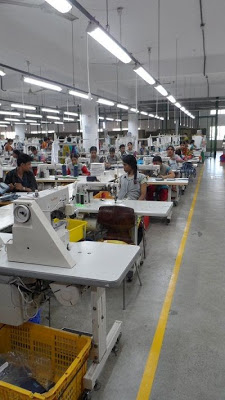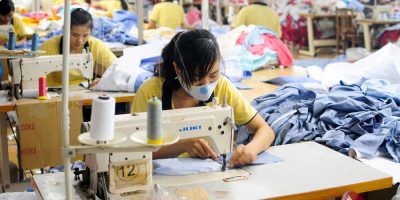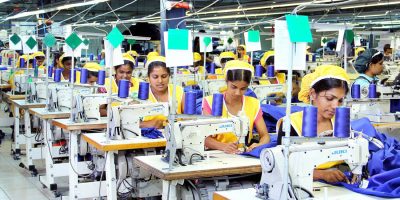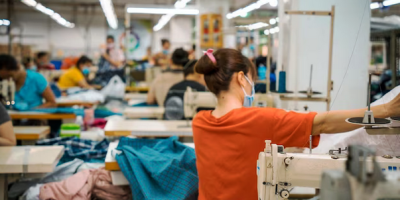Export-oriented apparel industry, popularly known as Ready-made Garments (RMG) industry that occupies a unique position in the economy of Bangladesh. This sector is playing a vital role in the socio-economic development of the country. But the industry is struggling with some problems. The fire and tragic loss of 111 workersin Tazreen factory on November 24 in Ashulia, the hub of Bangladesh’s ready-made garments (RMG) industry, has made headlines all over the world.
Like other 3rd world countries, Bangladesh is a developing country. Her economic development depends firstly on agriculture and secondly on industry. The garment industry has given the opportunity of employment to millions of unemployed, especially innumerable uneducated women of the country. It is making a significant contribution to the field of our export income. Bangladesh mainly exports garment item to the US and Europe and gain nearly 80% of the country’s export earnings. The country has more than 4,000 factories to employ between two and three million workers. Workers in this sector usually came from the rural area to change their livelihood and around 80% of whom are women.
These workers are capable of contributing to their own family member’s basic needs and helped to raise the status of women in their families and communities.
History of Garment Industry: In the 1950s, labor charges in the western world became higher organized by forming trade unions. Second world war and other changes provided workers greater right including higher pay, which resulted in higher cost of production. Retailers were searching suitable places to minimize production cost. Developing economies like Hong Kong, Taiwan, and South Korea presented themselves as excellent destinations for relocation because they had open economic policies and non-unionized and highly disciplined labor force that could produce high-quality products at cheaper costs.

To control the volume of imported RMG products from developing countries, Multi-Fiber Agreement (MFA) was made in 1974. The MFA agreement imposed an export rate at 6% that
increases every year from a developing country to a developed country. It also allowed developed countries to impose quotas on countries that exported at a higher rate than the bilateral agreements. In the face of such restrictions, producers started searching for countries that were outside the umbrella of quotas and had cheaper labor. This was when Bangladesh started receiving investment in the
RMG sector.
In the early 1980s, some Bangladeshi received free training from Korean Daewoo Company. When workers came back to Bangladesh, many of them broke ties with the factories. They started were working for and their individual companies.
Facts and figures: In the 1980s, only 50 companies were employing only a few thousand people. Currently, there are 4490 manufacturing units. The RMG sector contributes around 76% to the total export earnings. In 2007, it earned $9.35 billion. The government of Bangladesh has set 26.36 billion dollar export target for the fiscal year 2011-2012.
Development Factors: The prime factor why garment industries have come out to be the champion in the field of export is, of course, the cheapest labor. Country-wise per hour wage rates of garment workers is given below.
|
Country
|
Per hour Wages (US$)
|
|
Turkey
|
2.44
|
|
Mexico
|
2.17
|
|
China
|
1.07
|
|
Thailand
|
1.06
|
|
Philippine
|
0.84
|
|
Indonesia
|
0.54
|
|
Pakistan
|
0.56
|
|
Vietnam
|
0.52
|
|
Sri Lanka
|
0.44
|
|
|
0.34
|
|
India
|
0.34
|
|
Myanmar
|
0.27
|
|
Bangladesh
|
0.25
|
As labor cost is very low, RMG factories in Bangladesh can produce quality products at a reduced cost which has attracted the foreign buyers. International companies like Wal-Mart, JC Penney, H&M, Zara, Tesco, Carrefour, Gap, Metro, Marks & Spencer, Kohl’s, Levi Strauss and Tommy Hilfiger all import garments from Bangladesh.
Fire Incident at Garment Factories: Around 33 major fire incidents at garments factories claimed at least 500 lives between 1990 and 2012. Listed below are some disasters since 2000.
|
Date
|
Number of Death
|
Factory
|
|
25.11.2000
|
46
|
Chowdhury Knitwear Garments Factory
|
|
08.08.2001
|
24
|
Maico Sweater
|
|
06.01.2005
|
22
|
Shan Knitting and Processing Ltd.
|
|
23.02.2006
|
54
|
KTS Garment
|
|
25.02.2010
|
21
|
Garib & Garib Sweater
|
|
14.12.2010
|
26
|
Ha-Meem Group
|
|
24.11.2012
|
111
|
Tazreen Fashion
|
Fire service officials inspected 163 factories out of 574 in Ashulia after November 24 fire. The findings were appalling 53 of those inspected plants lacked minimum fire safety standards.
Cause of fire in Garments Factories: Cause of fire in garments factories is many. Some reason has given below.
* Insufficient firefighting equipment.
* Inappropriate maintenance of fire prevention system.
* Unsuitable and risky alternate exit.
* Lack of instruction for emergency evacuation in the gangway.
* Locking of the collapsible gate with the excuse of safety.
* Lack of preparation for emergency evacuation in the gangway.
* Disproportionate machinery and manpower.
* No rooftop door.
* Use of flammable materials.
* Improper house building, wiring, electric design and illegal connection.
* Working force without any fire training.
* National & International Conspiracy.
Recommendations for fire safety: A compliance checklist for garments industry regarding fire safety is listed below.
* Fire extinguisher all in good condition.
* Sufficient fire extinguisher.
* Fire extinguisher location list.
* Evacuation drill (External) file.
* Evacuation drill (External) every four months.
* Evacuation drill (Internal) file.
* Evacuation drill (Internal) every three months.
* Lack of sufficient
trained employees.
* Fire buckets to power room with water and sand.
* Fire buckets to boiler room with water and sand.
* Evacuation plan in all floor/area.
* Emergency exit on open.
* Emergency exit.
* Emergency exit signage.
* Emergency exit with open outdoor facility.
* Signage of emergency electricity switches off.
Labor unrest in RMG sector: Cause of labor unrest in RMG sector of Bangladesh is many. The
wages of the workers are little. Very often they do not get their salary, overtime bills, and bonus in time. They don’t know anything about their job contract. Being maltreated by the owners and mid-level officers they work long hours in a congested environment without sufficient rest. If any worker protests against owners or management, she/he is threatened by various types of harassment such as dismissal, arrest etc.
It is why labor unrest has been a common phenomenon in the RMG sector of Bangladesh. Workers are being embroiled in clashes frequently; they call strikers often to make their demand home. It causes enormous loss to the owners, cripples the economy and tarnishes the image of the country abroad. It also makes foreign buyers reluctant to render future orders.
Contributions of RMG sector to national Economy: Garment industry occupies a unique position in the economy of Bangladesh. It is the largest exporting sector in our country, which has experienced phenomenal growth during the last three decades. The industry plays a vital role in employment generation and the provision of income to the poor. More than 3.5 million workers are directly, and more than ten million people are indirectly associated with this sector. This industry has also played a significant role in the
socioeconomic development of the country.
Concerning GDP, RMG’s contribution is highly remarkable. It reaches 13% in FY 2009-10 which was only 3% in FY 1990-91. It is a clear indication of the industry’s healthy contribution to the overall economy. It plays a vital role to promote the development of the other key sectors of the economy like banking, insurance, hotel, housing, transport etc. Moreover, many backward industries like zipper, button, thread, label, printing, embroidery, packaging and other accessories industry have grown based on this sector. Many people have got employed in these industries.
Conclusion: Our garments industry can improve their position in the world by reducing overall problems.
Proper management including labor conflict management, policy development, zero misses, enriched training, fire safety system, convenient working schedule, healthy working environment, motivation etc. is to be ensured for that. Considering promotion and wages based on skill will lead them to reach their labor rights and their socioeconomic empowerment. The owners should comprehend to establish safe and secure environment inside the industries. They have to also responsible for the welfare of workers simultaneously. Have to organize training program for employees, mid-level officers, and the owners regularly. Moreover, garment owners and employees federation should sit together time to time to fix workers wages which can help them to maintain their livelihood. The government also has some responsibility to improve the situation by providing a proper policy to protect the garments industries. Besides this political parties should emphasize garments industry and favor this sector from any political violence.
 To control the volume of imported RMG products from developing countries, Multi-Fiber Agreement (MFA) was made in 1974. The MFA agreement imposed an export rate at 6% that increases every year from a developing country to a developed country. It also allowed developed countries to impose quotas on countries that exported at a higher rate than the bilateral agreements. In the face of such restrictions, producers started searching for countries that were outside the umbrella of quotas and had cheaper labor. This was when Bangladesh started receiving investment in the RMG sector.
To control the volume of imported RMG products from developing countries, Multi-Fiber Agreement (MFA) was made in 1974. The MFA agreement imposed an export rate at 6% that increases every year from a developing country to a developed country. It also allowed developed countries to impose quotas on countries that exported at a higher rate than the bilateral agreements. In the face of such restrictions, producers started searching for countries that were outside the umbrella of quotas and had cheaper labor. This was when Bangladesh started receiving investment in the RMG sector.



Leave a Reply
You must be logged in to post a comment.